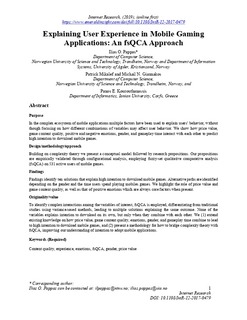Explaining User Experience in Mobile Gaming Applications: An fsQCA Approach
Journal article, Peer reviewed
Accepted version

Åpne
Permanent lenke
http://hdl.handle.net/11250/2603487Utgivelsesdato
2019Metadata
Vis full innførselSamlinger
Originalversjon
10.1108/IntR-12-2017-0479Sammendrag
Purpose In the complex ecosystem of mobile applications multiple factors have been used to explain users’ behavior, without though focusing on how different combinations of variables may affect user behavior. The purpose of this paper is to show how price value, game content quality, positive and negative emotions, gender and gameplay time interact with each other to predict high intention to download mobile games. Design/methodology/approach Building on complexity theory, the authors present a conceptual model followed by research propositions. The propositions are empirically validated through configurational analysis, employing fuzzy-set qualitative comparative analysis (fsQCA) on 531 active users of mobile games. Findings Findings identify ten solutions that explain high intention to download mobile games. Alternative paths are identified depending on the gender and the time users spend playing mobiles games. The authors highlight the role of price value and game content quality, as well as that of positive emotions, which are always core factors when present. Originality/value To identify complex interactions among the variables of interest, fsQCA is employed, differentiating from traditional studies using variance-based methods, leading to multiple solutions explaining the same outcome. None of the variables explains the intention to download on its own, but only when they combine with each other. The authors extend existing knowledge on how price value, game content quality, emotions, gender and gameplay time combine to lead to high intention to download mobile games; and present a methodology for how to bridge complexity theory with fsQCA, improving our understanding of intention to adopt mobile applications.